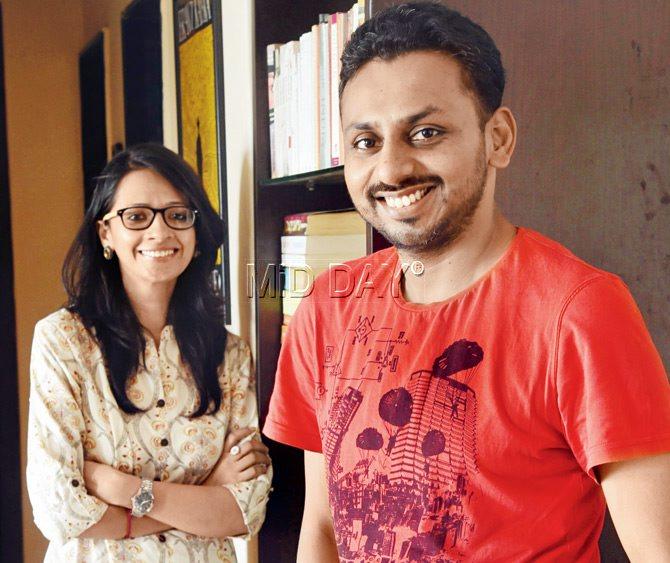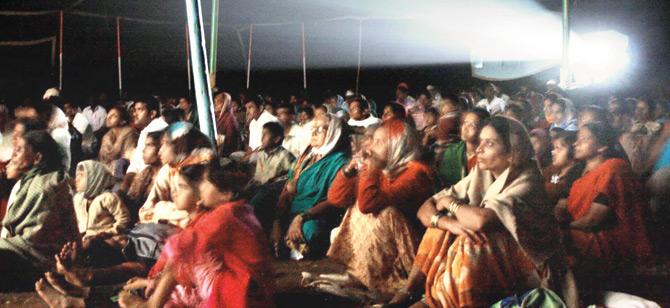Two filmmakers are headed to Cannes this month, with a documentary about endangered pop-up theatres in drought-hit Maharashtra

Researcher Shirley Abraham and photographer Amit Madheshiya took eight years to study and film The Cinema Travelers
ADVERTISEMENT
Only the French can think of a selection of cinema about cinema,” says photographer Amit Madheshiya. The Cinema Travelers, shot by him and co-directed and co-edited by researcher Shirley Abraham, will premiere at the 69th annual Cannes Film Festival in May. It features in a list that is sure to woo cinephiles, Nine Documentaries About Cinema — ‘a way to tell the history of cinema by cinema itself’. “Our film is about microcosms where people don’t travel to cinema; cinema comes to them, rather. It is how cinema was intended; the Lumiere Brothers took their films from city to city,” says Madheshiya, who has awards from World Press Photo and World Photography Awards to his credit.

Researcher Shirley Abraham and photographer Amit Madheshiya took eight years to study and film The Cinema Travelers. Pic/Nimesh Dave
The two filmmakers buzz about conversing with us and attending a phone ringing off the hook. The documentary has been eight years in the making, but post-production work still looms over their heads. Abraham has just got off the phone with
colourist S Manoj CPK Verma (who has wonderfully incorporated his entire family into his name), known to have worked on mainstream Bollywood titles like Black and Johnny Gaddaar. He has just shared a film memory, like others in the team, for the documentary. He was 11 when he watched Sadak (1991) — his first film on a big theatre screen.

Organisers, say the filmmakers, customise their content into what’s suitable for various members of the audience and on popular demand — mythology for women, action for boys, and soft porn for men. PIC/AMIT MADHESHIYA
That golden era still lives on in rural Maharashtra, it seems. Since 2008, Abraham and Madheshiya have journeyed to almost 40 villages in the hinterland. Picture this: Huge tent talkies, sometimes even up to 10, set up during jatras or temple fairs; pilgrims settling down by the thousands to watch SRK in Om Shanti Om or a Mithun flick; the organisers selecting mythological themes for women, action numbers for boys, and some well-intended soft porn for men into the late nights for about R20 a show. Abraham recollects a young boy who wanted to selectively view a film. “It cost R30 for Tujhe Meri Kasam (2003), and he wanted to watch just one gaana. He got a discounted rate of Rs 10.”
Movie cultures
The makers of this 96-minute documentary go on to say that there is no one way of enjoying a film anymore. Right from mobile phones to theatres, watching a film is now a democratic, independent exercise. But, nothing beats the accessibility or the communality of these pop-up theatres in Marathwada and Vidarbha. “In the mid-2000s, we spoke a lot about how single screen theatres were closing down in cities thanks to a digital takeover. But, what’s happening in the villages with this 70-year-old tradition of cinema?” says Madheshiya.
Three characters in the film — a young exhibitor who believes he has infused new hope for travelling cinema into the villagers, an older organiser who might be the last in his family to enter the business, and a projector mechanic famed to have modified several brands — are set against this backdrop of tents filled with viewers, their dreamy eyes peeled to the screen. It follows a rather unconventional path, reminiscent of this decade’s cutting-edge documentaries. It’s more magic realism, almost mythological. The story is about cinema, definitely, but as Madheshiya puts it — “a profound human experience”.
And, what with the quaint bioscope that springs up in music videos to showcase the spirit of the country, is a travelling cinema another relic from a bygone era? Did rural India stand still while the world moved on? Steering the fine line between Indian exotica and rural realism, Abraham (who has directed documentaries for The Guardian and Doordarshan) says, “While lavani and tamasha have found recognition as cultural experiences, travelling cinemas were yet to be thoroughly studied.”
“We have tons of beautiful images of the cinemas in my hard drive. But we have not used them in the film. Jonathan [Oppenheim, who saw the first screening of the rough cut in 2014 at Sundance Lab] kept asking us: What is the meaning of this film?” And for Madheshiya, sitting a pandal and watching a film is what he did as he did anyway as a five-year-old in his hometown, a village called Mau near Benares in Uttar Pradesh. “I ran away from home to watch Coolie at a tent just a mile away. A hue and cry was raised over that at home. I still remember the sound of the projector,” he says. His memory of the whirr of the projector guided the sound design for the film, conceptualised by Pete Horner, who Madheshiya and Abraham met at a Sundance Lab at Skywalker Sound. Horner, you will recall, is the sound designer and mixer for Hollywood blockbusters like Jurassic World and for documentaries alike.
Fading out
In the 1980s, at this industry’s peak, there were almost 300 travelling cinemas. Villagers tell Abraham and Madheshiya, that a remaining few teeter about. “While there are travelling cinemas in West Bengal and Uttar Pradesh, in Maharashtra, it continued as an organised, licensed setup,” says Madheshiya.
There was a time, the two say, when religious fairs would ask the cinema organisers to park, as a way of attracting crowds. “Now, with repeated droughts, patronage at these fairs has reduced so drastically that it is not economically viable anymore to invite an already-struggling cinema organiser,” says Abraham. There was a time when she sat in the projector cabin at a tent and watched a porn film play backwards because the projectionist fit the reel wrongly. Men pounded on the cabin, demanding justice, for the love of cinema.
 Subscribe today by clicking the link and stay updated with the latest news!" Click here!
Subscribe today by clicking the link and stay updated with the latest news!" Click here!







